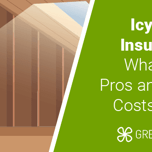Answer these simple questions and we will find you the BEST prices
Which type of solar quotes do you need?
It only takes 30 seconds
100% free with no obligation

Get Free quotes from insulation specialists near you

Save money by comparing quotes and choosing the most competitive offer

The service is 100% free and with no obligation
- GreenMatch
- Insulation
- Insulation Materials
Insulation Materials: List, Uses, Pros & Cons

- There’s a wide range of insulation materials available on the market, suited to all types of budgets, thermal efficiencies and personal preferences.
- The most popular thermal insulation materials tend to be mineral wool and fibreglass, ranging in cost from around £10 - £17.5.
- Thermal insulation materials do not provide sufficient acoustic insulation, and vice versa. Each group has its own suited materials.
Home insulation is one of the greatest domestic upgrades anyone can bring to their home. Just a combination of wall, floor and loft insulation can reduce your home’s heat loss by a staggering 67%, leading to sky-high energy bill savings, a reduced carbon footprint, and a comfortable home environment for decades to come.
But with all the insulating materials on the market, choosing the right fit for your home can seem daunting. There is no shortage of variety, from cost to efficiency, thermal to acoustic. This GreenMatch UK guide will give you everything you need to know about insulation materials, their best purposes, and how to choose the right fit for your home.
Ready to get your home insulated? Look no further than GreenMatch UK for all your needs. Spend just 30 seconds filling out our online form, and you can receive up to 3 free home-tailored quotes right from our network of trusted installers. No charges or obligations apply. Click the button below to begin!
- Describe your needs
- Get free quotes
- Choose the best offer
It only takes 30 seconds



Thermal insulation materials and their uses
Of the two main types of insulation, thermal insulation is perhaps the most important for a home's livelihood. These are materials that help your house retain inner temperature, keeping it warm during winter and cool during summer.
Without proper thermal insulation, your energy system is at risk of working overtime, constantly attempting to make up for the lost heat. This can lead to unnecessarily high energy bills, a huge domestic carbon footprint, and an uncomfortable living environment.
In terms of popularity, the best thermal insulating material is probably mineral wool, but there’s a broad range of good insulation materials available, each with its price range, efficiency (r-value) and best-fitted purpose.
Here’s a hypothetical look at what a fully insulated home may contain as an insulation material:

Mineral wool

Mineral wool is one of the most popular materials used for insulation due to being budget-friendly, sustainable and versatile. Costing around £13 - £17.5, mineral wool can be found as rock wool or glass wool, made from recycled rock or glass respectively.
Its versatile nature, such as blown insulation, sheets, and batts, allows it to be used in many house insulation projects, such as floors, lofts, and internal (stud) walls.
Pros
- Budget-friendly
- Relatively sustainable
- Can be installed DIY
Cons
- Lackluster thermal performance
- Can irritate skin and eyes in direct contact
- May leech moisture if installed poorly
Fibreglass
Fibreglass is a material used for insulation that is very similar to mineral wool, in the sense that it can be found as loose fill, sheets, and batts, and has similar thermal insulation properties. At an easy £10 per m2, fibreglass is one of the most affordable insulating materials on the market.
Alongside its versatility, fibreglass is also pretty sustainable, mainly made from recycled glass products and able to be recycled into new fibreglass after use. It’s commonly used when insulating roof rafters, loft floors, inner stud walls and more.
Pros
- Decent cost-to-performance ratio
- Versatile
- Flame resistant
Cons
- Can irritate skin and eyes in direct contact
- Requires vapour barrier to protect from moisture
- Inhaled particles can cause respiratory damage and illness
Cellulose
Cellulose insulation is one of the most affordable and sustainable materials one could come by. Made almost entirely from recycled paper and wood products, cellulose costs around £10 - £12 per m2 of loose fill material.
Cellulose is typically applied as blown-in insulation, or loose-fill in areas such as lofts, cavity insulation and stud walls, and suspended timber floors.
Pros
- Highly sustainable
- Entirely recyclable
- Budget-friendly
Cons
- Highly prone to moisture
- Prone to clumping and degradation
- Can promote mould and mildew growth
PIR boards

Made from polyisocyanurate, PIR boards are rigid insulation sheets that can conveniently be cut to shape and boast exceptional thermal insulation capabilities. Costing around £5 – £15 per m2 depending on material density, these handy boards are often used to insulate roof rafters as loft insulation boards, internal and external walls, and solid concrete floors.
One downside is that polyisocyanurate is a synthetic polymer, making it difficult, energy-consuming and unsustainable to produce and recycle.
Pros
- Superior thermal efficiency
- Very robust against damage and weathering
- Flame resistant
Cons
- Unsustainable to produce and recycle
- Quite expensive
Spray foam
Mainly found as polyurethane foam, this expanding liquid spray foam insulation boasts one of the highest thermal efficiencies available today. Costing a hefty £21.5 or more per m2, it’s also one of the most successful materials in creating an air barrier.
This versatile foam is suitable for a range of applications, such as floors, insulation for walls, lofts and window and door frames. A downside however is that spray foam is notoriously unsustainable and risks off-gassing harmful toxins and volatile organic compounds (VOCs) during and after application.
Pros
- Superior thermal performance
- Airtight barrier
- Very versatile application
Cons
- Highly unsustainable
- Off-gasses toxic chemicals during installation
- Can damage property value
Acoustic insulation materials
Different to thermal insulation materials, acoustic insulation materials are tailored to block and reflect sound from entering or exiting your home, creating a more peaceful home environment. Acoustic materials differ from thermal materials by having a much higher density.
One of the most effective materials on the market today is acoustic cotton wool, high in density and very effective in muffling sound transfer, but there are several other alternatives.
Cotton wool
Cotton wool is considered to be one of the most effective mono materials when it comes to acoustic insulation. Costing just around £10 - £14 per m2, a California State Science Fair study had shown that cotton wool possesses superior qualities when it comes to noise cancelling.
High-density cotton wool is also a relatively recyclable insulation material, making it a choice for noise-cancelling materials that don’t need discarding.
Pros
- Recyclable
- Highly effective in sound absorption
Cons
- Airborne particles can cause respiratory problems
- The production of cotton wool is highly unsustainable
Acoustic mineral wool
Similar to thermal mineral wool, but at a much higher density, acoustic mineral wool is a material which still exhibits thermal properties, but is tailored for noise cancellation. For effectiveness, mineral wool is produced at a high density of 45kg/m3 or more, making it successful in muffling sound waves.
Acoustic mineral wool generally costs around £13 - £17.5 per m2 but can cost more depending on the material density. Like mineral wool, it is also a relatively sustainable and recyclable material choice.
Pros
- Relatively efficient in noise absorption
- Relatively sustainable and recyclable
- Budget-friendly
Cons
- Weak noise cancellation performance
- Can irritate skin and eyes when in contact
Mass-loaded vinyl (MLV)
Mass-loaded vinyl is by far one of the most effective ways to completely cancel noise transfer from inside and outside your home. Costing around £15 - £50 depending on density, MLV doesn’t just absorb noise, but completely reflects it, making it one of the most effective noise-cancelling materials.
Pros
- Superior noice cancellation
- High density and low material thickness
Cons
- Prone to tearing due to being thin
- Risks chemical off-gassing toxins if too warm
Acoustic plasterboard
These specialised building materials are made from a combination of gypsum plaster and other materials such as mineral wool to create a robust and effective sound barrier. Generally costing around £14 - £19 per m2, acoustic plasterboards can easily be behind interior (stud) walls or floors.
Pros
- Can provide a little bit of added thermal insulation
- Very durable and robust
Cons
- Relatively high cost per m2
- Effectiveness requires complex installation
Choosing the right insulation material
The best type of insulation for homes hinges on several factors, such as your budget, needs, home conditions, existing insulation and many more. Your best bet is to conduct a house assessment with a professional installer to get guidance on what materials would best suit your needs.
Nevertheless, here are some key tips on what to consider when making your decision:
- Purpose: Are you looking for thermal or acoustic insulation? It’s good to know that each group has materials that are specifically suited to the purpose. Thermal insulation does not contain effective acoustic properties, and vice versa.
- Budget: How much are you willing to spend? As a general rule of thumb, the more effective a material is in retaining heat, the more it will cost. However, there are plenty of budget-friendly materials that are effective enough in insulating your home.
- Existing insulation: Does your home have any insulation in place already? If this insulation is healthy and functional, you can top it up for a fraction of the cost of a fresh installation. If not, it may require removal and replacement.
- Sustainability: How environmentally friendly do you want your home to be? A lot of thermally effective insulation materials are unfortunately unsustainable, made from unrecyclable polymers and posing a risk of off-gassing harmful toxins. Aim for sustainable alternatives like cellulose, sheep's wool, and cork where possible.
With the sea of materials and installers on the market, finding your right fit can be very daunting. That’s why your best bet is to work with professional insulation installers. To add pressure, not everyone has endless hours on end to spend on research and vetting. Luckily, GreenMatch UK can free you of this burden at the click of a button.
By filling out our simple 30-second online form, we can connect you with up to 3 free home-tailored quotes from our nationwide network of pre-vetted installers. The best part? Our services are completely free of charge and without any obligations. Simply click the button below to begin!
- Describe your needs
- Get free quotes
- Choose the best offer
It only takes 30 seconds



FAQ
In terms of popularity, the best insulation material is mineral wool or fibreglass, due to its affordability, versatile use and wide availability. In terms of thermal performance, however, there are materials like PIR boards, spray foam, and EPS polystyrene that have higher R-values.
There is a wide range of insulation materials used in the UK, suited for a variety of applications and purposes. Most commonly, one could find blanket-style insulation materials like mineral wool, fibreglass and sheep wool. More popular today, cavity walls are also being insulated with EPS polystyrene beads.
The cheapest insulation material on the market is usually fibreglass. While it may have a lower heat retention, its efficiency-to-cost ratio makes it a worthwhile investment.
Thermal insulation materials are those that have been specifically designed and tailored to help your home retain heat and reduce temperature transfer from inside to outside, and vice versa. A material’s ability to resist heat transfer is measured by a r-value. The higher the R-value, the better a material is at resisting heat transfer.

Akif is a copywriter at GreenMatch since 2023. With a keen interest in community sustainability, green solutions and the role of digital media in identifying climate trends, he aims to hone in on his background in International Studies and Digital Media to provide a multidisciplinary approach to written content rooted in credible research and accuracy.
We strive to connect our customers with the right product and supplier. Would you like to be part of GreenMatch?



